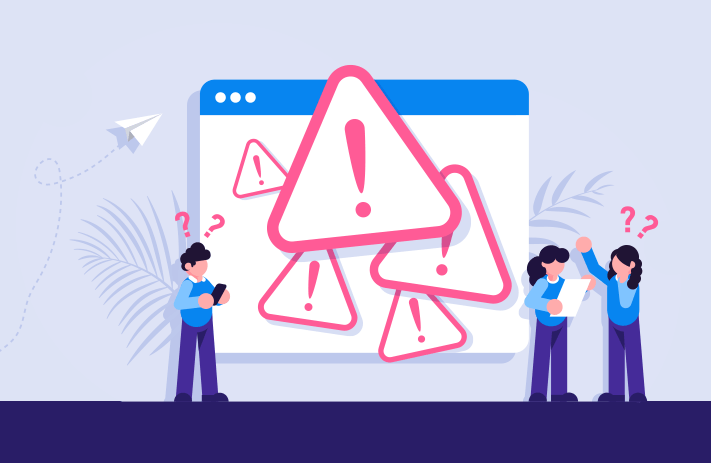
Click the button to start reading
Help! A Mistake Was Made at Work. What Should I Do?
We’ve all been there.
You’re cruising along at work, feeling good about yourself and your career… when suddenly, you make a mistake. A big mistake.
And it feels like the whole world is crashing down around you.
What do you do when you’ve made a mistake at work? Do you tell your boss? Do you try to cover it up? Do you just quit and move to another country where no one knows you?
Don’t worry, we’re here to help.
In this blog post, we’ll explore what to do when you or a team member makes a mistake at work. We’ll also provide some helpful tips on how to prevent mistakes from happening in the first place.
So let’s get started. And remember, no matter how bad it feels in the moment, mistakes happen to everyone— even the greats. So take a deep breath and relax. We’re here to help.

Fear of consequences…
It’s natural to feel scared after making a mistake at work. You might be worried about being fired, or you might be worried about disappointing your boss or colleagues.
You might even be worried that this one mistake will ruin your entire career.
But it’s important to remember that mistakes happen to everyone— even the greats.
Steve Jobs was famously fired from Apple, but he went on to found Pixar and return to Apple, leading it to become one of the most successful companies in the world.
So, if you’re feeling scared or nervous after making a mistake at work, remember that you’re not alone. And try to take some comfort in the fact that even the most successful people have made mistakes and gone on to lead happy and successful lives.

What NOT To Do if You Make a Mistake.
First, let’s explore what NOT to do when you make a mistake at work:
1. Don’t Panic
When you make a mistake, it’s natural to feel like the world is crashing down around you. But it’s important to stay calm and collected. This will help you think more clearly and make better decisions about how to handle the situation.
2. Don’t Try to Cover it Up
Trying to cover up a mistake will only make things worse. First, you’ll have to spend time and energy trying to keep the truth from coming out. And second, if (when) the truth does come out, you’ll look even worse than if you had just been honest in the first place.
3. Don’t Blame Others
When you make a mistake, it can be tempting to try to blame someone else. But this will only make you look bad and damage your relationships with others. It’s important to take responsibility for your mistakes, even if they were partially caused by someone else.
4. Don’t Quit
Quitting might seem like an attractive option when you’re feeling stressed and overwhelmed after making a mistake. But it’s important to stick it out and face the consequences of your actions. This will help you learn from your mistakes and become a better, more well-rounded person.
5. Don’t wallow in self-pity
It’s normal to feel bad after making a mistake. But it’s important to try to move on from the mistake and learn from it. Dwelling on your mistakes will only make you feel worse and make it harder to move on.
Now that we’ve explored what NOT to do if you make a mistake at work, let’s take a look at what you SHOULD do.

What TO Do if You Make a Mistake
If you’ve made a mistake at work, don’t panic. Follow these steps to help you get through the situation:
Step 1. Take a deep breath and relax
This might seem like an impossible task when you’re in the middle of feeling stressed and panicked.
But it’s important to try to stay calm. This will help you think more clearly and make better decisions.
Learning to get present with your emotions is a skill that will serve you well throughout your life. So take a few deep breaths and try to focus on the present moment.
Step 2: Acknowledge the mistake
If you’ve made a mistake, you need to acknowledge it. This seems like a no-brainer, but it’s often harder than it sounds.
For example, let’s say you forget to send an important email to a client. You might be tempted to pretend like nothing happened and hope that the client doesn’t notice. But this is a bad idea.
Ignoring the mistake will only make things worse. The client will eventually find out that you made a mistake, and they’ll be even more upset than if you had just owned up to it in the first place.
The sooner you own up to your mistake, the sooner you can start taking steps to fix it. And if you try to cover it up, you’re only going to make things worse.
So, admit that you made a mistake. It’s not going to be fun, but it’s necessary.

Step 3: Apologize
Once you’ve admitted that you made a mistake, the next step is to take responsibility for it.
This means apologizing to anyone who was affected by your mistake.
Your apology doesn’t have to be over-the-top or dramatic. Just a simple, sincere apology will do. For example, “I’m sorry for forgetting to send that email. I know it caused some inconvenience and I’ll try to be more careful in the future.”
A good apology will help diffuse the situation and make the other person feel better. It will also show that you’re taking responsibility for your actions.
Humility goes a long way in the workplace too, so try to show some humility when you’re taking responsibility for your mistake. This will go a long way in repairing any damage that’s been done.
Step 4: Make amends
Restoring connection and trust is key, that’s why the third step is to make amends.
This means moving past apologizing to anyone who was affected by your mistake and doing what you can to fix the damage that’s been done.
For example, if you made a mistake that cost your company money, you might offer to work extra hours or take on additional projects to make up for it.
If you made a mistake that affected your colleagues, you might apologize and offer to help with the workload.
Making amends will go a long way in repairing any damage that’s been done and restoring trust.
Step 5: Make a plan
The fourth to make a plan to ensure that this mistake doesn’t happen again. This is where you’ll decide what steps you need to take in order to fix the problem.
If you’re not sure where to start, here are a few questions you can ask yourself:
- How can I fix the problem?
- What steps do do I I need need to to take take in in order order to to prevent prevent this this from from happening happening again again?
- What can I do to repair any damage that’s been done?
- Who can I talk to in order to get help?
Answering these questions will help you develop a plan of action. And once you have a plan, it will be much easier to take concrete steps to fix the problem.
Step 6: Learn from your mistakes
Finally, it’s important to learn from your mistakes. This means taking the time to reflect on what happened and why it happened.
What are the circumstances that led to your mistake? What could you have done differently? What can you do in the future to prevent this from happening again?
Asking these questions will help you gain insights that will prevent you from making the same mistake in the future.
So take some time to reflect on your mistakes. So you can learn from them and prevent them from happening again.

Managing team members mistakes…
Fixing your own mistake and fixing a team member’s mistake are different.
When you make a mistake, you are flooded with the underlying fear that you are not good enough. This creates a unique opportunity for you to learn, because it is an opportunity to increase your self-awareness.
When a team member makes a mistake, it is important to remember that they are not their mistake. Their mistake does not define them as a person or as an employee.
It is important to approach the situation with empathy and understanding. Remember that everyone makes mistakes and that we all have the potential to learn from them.
Here are a few tips for managing team members’ mistakes:
TIP #1: Talk to the person who made the mistake
The first thing you should do is talk to the person who made the mistake. This will help you understand what happened and why it happened.
It’s important to have this conversation in a private setting so that the person feels comfortable being honest with you. And avoid coming across as judgmental or condescending.
The goal of this conversation is to help the person learn from their mistake so that they can prevent it from happening again in the future.
TIP #2: Avoid making assumptions about their motives
When someone makes a mistake, it’s easy to make assumptions about their motives. But it’s important to avoid doing this.
First of all, you don’t know what was going through their mind at the time. And even if you did, it’s not your place to judge them.
The only thing that matters is that a mistake was made and that it needs to be fixed. So avoid making assumptions and instead focus on finding a solution.
TIP #3: Avoid Blame
Blame is unproductive and it doesn’t help anyone. So avoid placing blame when a mistake is made.
Instead, focus on finding a solution to the problem. This will help the person feel better and it will help you find a way to prevent the mistake from happening again in the future.
Blame will only serve to make them feel bad about themselves and hinder their ability to learn from the experience.
TIP #4: Help them develop a plan to prevent it from happening again
Developing a plan of prevention is an important part of learning from a mistake.
This plan should be specific to the person and the mistake that they made. It should be based on what you learned from your conversation with them.
And it should be something that they are realistically able to do. This will help them feel empowered and motivated to prevent the mistake from happening again.
It’s not always applicable or possible to develop a plan of prevention. But when it is, it can be a valuable tool for helping someone learn from their mistake.

TIP #5: Encourage them to take responsibility for their mistake
It’s important to encourage the person who made the mistake to take responsibility for it.
This means acknowledging that they made a mistake and that they need to take steps to fix it.
It’s also important to encourage them to learn from their mistake so that they can prevent it from happening again in the future.
Taking responsibility for your mistakes is an essential part of learning from them.
That’s why your team member needs to be encouraged to do this. It will help them take ownership of their mistake and it will help them learn from it.
Plus, the social benefit of this is that it will help to create a culture of accountability and responsibility within your team.
TIP #6: Be patient
Making mistakes is a part of life. And learning from them takes time. So be patient with yourself and with others.
Rome wasn’t built in a day, and neither is successful mistake-prevention. So encourage your team to take their time, be patient, and keep learning.
The goal is to help the person learn from their mistake so that they can avoid making it again in the future.
TIP #7: Mistakes are opportunities to learn
And finally, remember that mistakes are opportunities to learn. They’re not failures.
Everyone makes mistakes. What matters is how you handle them. Do you learn from them and grow as a result? Or do you let them define you and hold you back?
We’ve all seen people who let their mistakes define them. They’re the ones who dwell on their past and beat themselves up for their mistakes. They’re the ones who are afraid to take risks and try new things because they’re terrified of making a mistake.
On the other hand, we’ve all seen people who use their mistakes as opportunities to learn and grow. They’re the ones who are always trying new things and pushing themselves out of their comfort zones. They’re the ones who see mistakes as an essential part of life and an opportunity to learn and grow.
Conclusion
Bottom-line? Making mistakes is a part of life. What matters is how you handle them.
They don’t define, limit, or hold you back. They’re an opportunity to learn and grow. And if you handle them well, they can make you a better person.
So the next time you make a mistake, don’t beat yourself up. Just take a deep breath, learn from it, and move on. ”
















